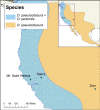Remating responses are consistent with male postcopulatory manipulation but not reinforcement in D. pseudoobscura
- PMID: 28116047
- PMCID: PMC5243186
- DOI: 10.1002/ece3.2628
Remating responses are consistent with male postcopulatory manipulation but not reinforcement in D. pseudoobscura
Abstract
Reinforcement occurs when hybridization between closely related lineages produces low-fitness offspring, prompting selection for elevated reproductive isolation specifically in areas of sympatry. Both premating and postmating prezygotic behaviors have been shown to be the target of reinforcing selection, but it remains unclear whether remating behaviors experience reinforcement, although they can also influence offspring identity and limit formation of hybrids. Here, we evaluated evidence for reinforcing selection on remating behaviors in Drosophila pseudoobscura, by comparing remating traits in females from populations historically allopatric and sympatric with Drosophila persimilis. We found that the propensity to remate was not higher in sympatric females, compared to allopatric females, regardless of whether the first mated male was heterospecific or conspecific. Moreover, remating behavior did not contribute to interspecific reproductive isolation among any population; that is, females showed no higher propensity to remate following a heterospecific first mating than following a conspecific first mating. Instead, we found that females are less likely to remate after initial matings with unfamiliar males, regardless of species identity. This is consistent with one scenario of postmating sexual conflict in which females are poorly defended against postcopulatory manipulation by males with whom they have not coevolved. Our results are generally inconsistent with reinforcement on remating traits and suggest that this behavior might be more strongly shaped by the consequences of local antagonistic male-female interactions than interactions with heterospecifics.
Keywords: allopatry; coevolution; reproductive isolation; sexual conflict; speciation; sympatry.
Figures



References
-
- Anderson, W. W. , & Kim, Y. K. (2005). Sexual isolation between sympatric and allopatric populations of Drosophila pseudoobscura and D. persimilis . Behavior Genetics, 35, 305–312. - PubMed
-
- Anderson, W. W. , & Kim, Y. K. (2006). A further analysis of sexual isolation between sympatric and allopatric populations of Drosophila pseudoobscura and D. persimilis—Rejoinder to Noor and Ortiz‐Barrientos. Behavior Genetics, 36, 328–330. - PubMed
-
- Arnqvist G., & Rowe L. (Eds.) (2005). Sexual conflict. Princeton, NJ, USA: Princeton University Press.
-
- Butlin, R. (1987). Speciation by reinforcement. Trends in Ecology & Evolution, 2, 8–13. - PubMed
LinkOut - more resources
Full Text Sources
Other Literature Sources
Molecular Biology Databases

